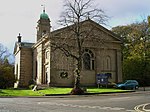Park Road, Buxton
Park Road is a cricket ground in Buxton, Derbyshire, England. It is the home ground of Buxton Cricket Club, and was formerly used by the Derbyshire County Cricket Club first XI between 1923 and 1986. The first First-class match on the ground was in June 1923, when Derbyshire faced the touring West Indians. The ground’s biggest claim to fame was in 1975, when the second day’s play of the County Championship match against Lancashire was wiped out due to snow. Derbyshire generally played one County Championship match at Buxton every year from 1930 to 1976, but have only played there four times since. The most recent first-class match was in August 1986 against Lancashire, who have provided the opposition for 26 of the 48 first-class games at the ground. The ground also hosted ten Derbyshire List A fixtures between 1969 and 1986. Game information: Game statistics: first-class: Game statistics: one-day:
Excerpt from the Wikipedia article Park Road, Buxton (License: CC BY-SA 3.0, Authors).Park Road, Buxton
Park Road, High Peak
Geographical coordinates (GPS) Address Nearby Places Show on map
Geographical coordinates (GPS)
| Latitude | Longitude |
|---|---|
| N 53.259722222222 ° | E -1.9211111111111 ° |
Address
Park Road
Park Road
High Peak
England, United Kingdom
Open on Google Maps











